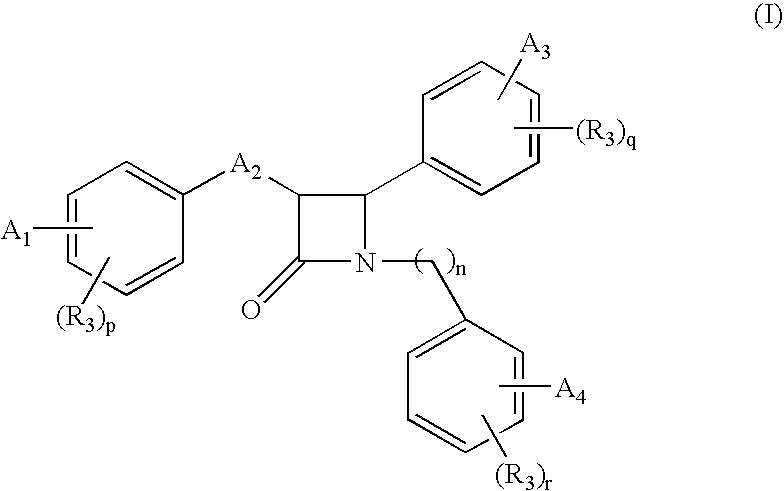Β-lactam compounds process for reproducing the same and serum cholesterol-lowering agents containing the same
a technology of -lactam and compounds, applied in the field of new drugs, can solve problems such as unfavorable side effects reported
- Summary
- Abstract
- Description
- Claims
- Application Information
AI Technical Summary
Benefits of technology
Problems solved by technology
Method used
Image
Examples
example 1
[0216](I) To a solution of the compound (1-5) (3.46 g) in toluene (54.0 mL) were added molecular sieve (3.46 g), a catalytic ammount of p-toluenesulfonic acid and p-fluoroaniline (0.61 mL). The mixture was refluxed for 1.5 hr and filtered. The solvent was removed under reduced pressure and the residue was subjected to the next reaction without purification.
[0217](II) To the solution of the compound obtained above in toluene (54.0 mL) were added tributylamine (5.1 mL) and 5-(4-fluorophenyl)pentanoyl chloride (1.16 g). After the mixture was refluxed for 15 hr and 1 N hydrochloric acid (15 mL) was added to the mixture and the mixture was stirred for 15 min. The organic layer was separated and washed with saturated sodium bicarbonate solution, brine and dried over anhydrous sodium sulfate and concentrated. The residue was subjected to the next reaction without purification.
[0218](III) The solution of the compound obtained above in methanol-tetrahydrofuran (5 / 1) (6 mL) was hydrogenated a...
example 2
Synthesis of Compound 3
4-(4-([(5S,2R,3R,4R,6R)-3,4,5-triacetoxy-6-(acetoxymethyl)-perhydro-2H-pyrane-2-yl]methyl}phenyl)-(4S*,3S*)-1-(4-fluorophenyl)-3-[3-(4-fluorofenyl)propyl]azetidine-2-one
[0220]
[0221]To a solution of the compound 2 (600 mg) in dichloromethane (11.0 mL) were added triethylamine (0.77 mL), acetic anhydride (0.49 mL) and a catalytic ammount of 4-dimethylaminopyridine. The mixture was stirred at room temperature for 16 hr. The organic layer was washed with brine, dried over anhydrous sodium sulfate and concentrated. The residue was purified by silica gel column chromatography (ethyl acetate / hexane=1 / 2) to give 600 mg (77%) of the compound 3.
[0222]Mass (ESI) m / z: 722 (M+H)+ IR (KBr): 1749, 1506, 1380, 1221, 1029 cm−1 1H-NMR (CDCl3): 1.82˜1.84(m,4H), 1.93(s,3H), 1.97(s,1.5H), 1.98(s,1.5H), 1.99(s,1.5H), 2.00(s,1.5H), 2.02(s,3H), 2.61˜2.64(m,2H), 2.79˜2.82(m,2H), 3.07˜3.08(m,1H), 3.56˜3.69(m,2H), 4.02˜4.23(m,2H), 4.58(d,J=2.4 Hz), 4.89˜4.95(m,1H), 5.03(t,J=9.3 Hz), 5.1...
example 3
2-(4-[4-{(5S,2R,3R,4R,6R)-3,4,5-trihydroxy-6-(hydroxymethy)-perhydro-2H-pyran-2-yl}methyl]phenyl)(4S*,3R*)-1-(4-fluorophenyl)-3-[3-(4-fluorophenyl)propyl]-2-oxazetidineyl)phenoxy-2-methylpropanoic acid
[0235]
[0236](I) To a solution of the compound (4-4) (3.19 g) in acetone (22.0 mL) were added ethyl 2-bromo-2-methylpropionate (0.77 mL) and potassium carbonate (0.97 g). The mixtue was refluxed for 40 hr, filtered, and concentrated. The residue was purified by silica gel column chromatography (ethyl acetate / hexane=1 / 3).
[0237](II) A solution of the compound 18 (2.93 g) obtained above in ethanol-tetrahydrofuran (1 / 1) (40 mL) was hydrogenated at room temperature for 3 hr in the presence of 10% palladium on carbon (0.3 g). After removal of the catalyst, the filtrate was evaporated. The residue was purified by silica gel column chromatography (chloroform / methanol=10 / 1) to give 1.21 g (2 steps 51.8%) of the compound 18.
[0238]
[0239]To a solution of the compound 18 (400 mg) in tetrahydrofuran-...
PUM
| Property | Measurement | Unit |
|---|---|---|
| body weight | aaaaa | aaaaa |
| temperature | aaaaa | aaaaa |
| temperature | aaaaa | aaaaa |
Abstract
Description
Claims
Application Information
 Login to View More
Login to View More - R&D
- Intellectual Property
- Life Sciences
- Materials
- Tech Scout
- Unparalleled Data Quality
- Higher Quality Content
- 60% Fewer Hallucinations
Browse by: Latest US Patents, China's latest patents, Technical Efficacy Thesaurus, Application Domain, Technology Topic, Popular Technical Reports.
© 2025 PatSnap. All rights reserved.Legal|Privacy policy|Modern Slavery Act Transparency Statement|Sitemap|About US| Contact US: help@patsnap.com



